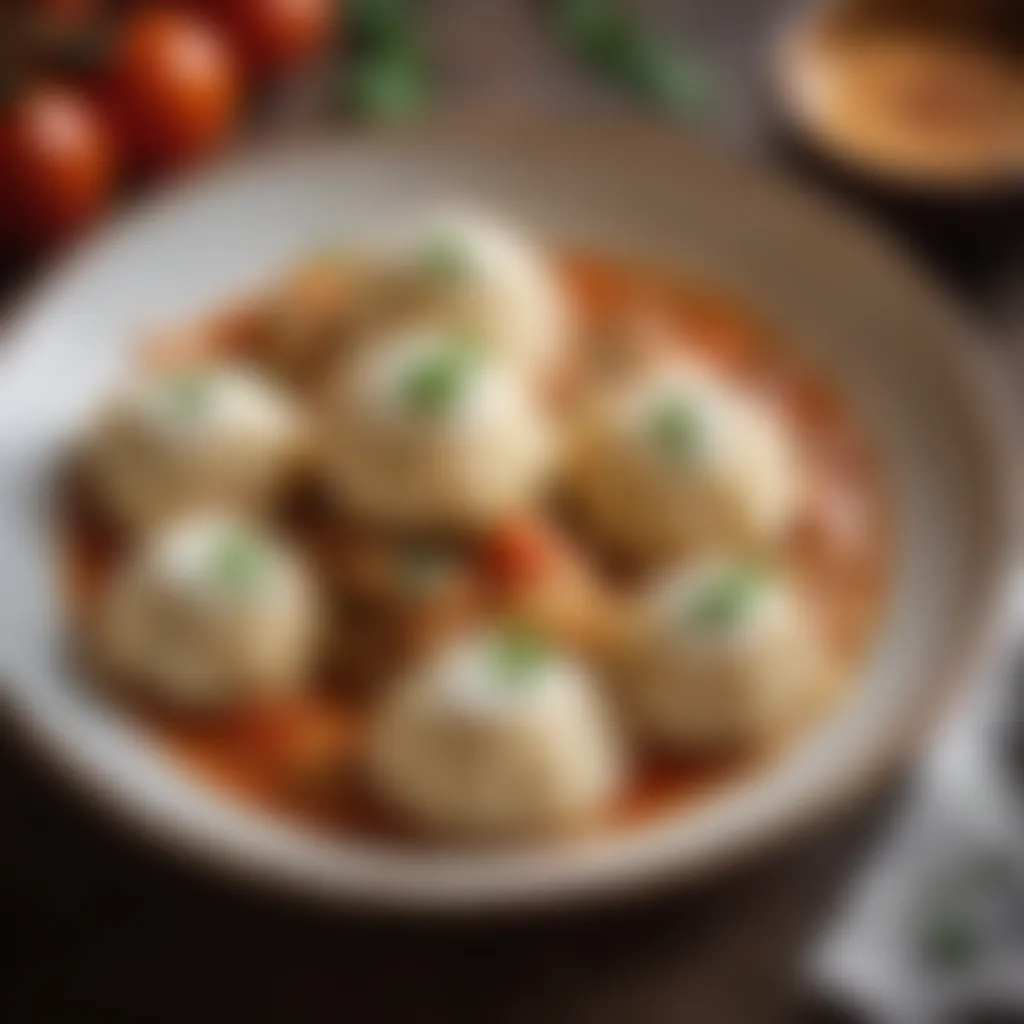Exploring the Rich Culinary Traditions of Afghanistan


Intro
Afghan cuisine, often overlooked in the grand tapestry of world gastronomy, boasts a rich history steeped in tradition and cultural influences. The complexity and depth of flavors within Afghan dishes reflect not only the agricultural bounty of the region but also centuries of culinary exchange along trade routes, such as the ancient Silk Road. This journey explores the heart and soul of Afghan cooking, shedding light on its distinctive ingredients, time-honored techniques, and the cultural significance embedded in every meal.
Food in Afghanistan is more than mere sustenance; it’s a vital thread woven into the fabric of social gatherings and celebrations. From intimate family dinners to grand feasts during weddings, each dish tells a story of heritage and hospitality. As we uncover the many layers of Afghan cuisine, we will gain insight into what truly makes this culinary tradition a treasure worth celebrating.
Let us venture forth into the vibrant world of spices, grains, and flavors that define Afghan cooking, beginning with the essential components that transform simple ingredients into a symphony of taste.
An Overview of Afghan Cuisine's Rich Heritage
Afghan cuisine offers a vivid tapestry of flavors, textures, and aromas that tell profound stories of the country’s history and culture. Central to this culinary exploration is the understanding of how Afghan food unites diverse traditions and influences.
The importance of this heritage cannot be overstated. Afghan cuisine serves as a reflection of the nation's identity, shaped by the tumultuous events of its past and the myriad cultures it has encountered through the centuries. This section sheds light on the specific elements that contribute to this rich heritage, which includes unique cooking techniques, staple ingredients, and the cultural significance of meals shared among families.
Historical Influences on Afghan Cooking
Afghanistan's location at the crossroads of ancient trade routes, such as the Silk Road, has made its cuisine a melting pot of flavors and techniques. Over many centuries, various empires, including Persian, Greek, Indian, and Mongol, have left their mark on Afghan gastronomy. This has resulted in an intricate layering of culinary practices.
For instance, the introduction of rice from the East combined with spices from the Mediterranean has given rise to iconic dishes like Kabuli Pulao. Moreover, the impact of nomadic tribes, who brought their traditional methods of preparation and cooking, has enriched the complexity of Afghan flavors. Consider the slow-cooking techniques that allow dishes to develop depth over many hours, or Tandoor baking, which not only adds a smoky flavor to bread but also involves communal cooking—a practice that builds community bonds.
The Fusion of Cultures in Afghan Flavors
What sets Afghan cuisine apart is its ability to embrace and incorporate a multitude of culinary influences while retaining a distinct identity. The fusion of cultures in Afghan flavors is most evident in the use of ingredients like pomegranates and walnuts, which are both symbolic and widely utilized in various dishes.
Key Points of Fusion:
- The spice blend known as "advieh" combines cardamom, cinnamon, and cumin, showcasing Persian influences.
- Garnishes often feature cilantro and mint, elements brought in through trade with neighboring regions.
- Traditional meat preparations reflect both Islamic customs and local agricultural practices, providing a unique twist to the meat dishes enjoyed across gateways and borders.
This blending of flavors not only caters to a diverse palate but also tells a story of resilience and adaptability\
"Food is a window into a culture, and in Afghanistan, it reflects centuries of history and human connection."
In exploring Afghan cuisine’s rich heritage, one uncovers not just recipes, but narratives shaped by the land, the people, and their experiences. This understanding lays a strong foundation for appreciating the unique culinary practices that identify Afghanistan’s place in the grand mosaic of world cuisines.
Key Ingredients in Afghan Cuisine
The heart and soul of Afghan cuisine lies deeply in the key ingredients that flavor its dishes. Understanding these elements not only enhances appreciation for Afghan food but also connects cooks and food lovers to the rich traditions and history behind each meal. Ingredients in Afghan cooking are more than mere components; they embody cultural identity and evoke memories. They are the lifeblood that brings communal meals to vibrant life, fostering bonds among family and friends.
Staples of Afghan Food
Breads and Grains
Breads and grains form the backbone of Afghan meals, serving as the essential base for various dishes. The most iconic of these is naan, a flatbread baked in a tandoor, which complements nearly every meal. Much more than simply a side, naan is often used to scoop up savory stews and grilled meats, making it a necessity on the dinner table.
Grains, particularly rice, are also vital. Dishes like Kabuli Pulao showcase rice's ability to absorb rich flavors. The long-grain basmati rice is a preferred variety, known for its fragrant aroma and fluffy texture. The unique feature of Afghan rice is that it is often tinted with saffron or mixed with raisins and nuts, enhancing its flavor profile.
This emphasis on breads and grains not only elevates meals but offers nutritional benefits such as energy and fiber. However, it's essential to ensure that these staples are made fresh for the best taste and texture.
Meat and Poultry
In Afghan cuisine, meat and poultry take center stage, reflecting the country’s pastoral culture. Lamb, beef, and chicken are frequently used, each offering distinct flavors and textures. For example, lamb is often marinated and grilled or cooked in stews, while chicken may be simmered or spiced for kebabs. This versatility makes meat a crowd-pleaser, suited for various dishes.
What is particularly compelling about Afghan meat preparation is the reliance on slow cooking, which allows flavors to meld beautifully. Kebabs, marinated pieces of meat grilled to perfection, stand out for their smoky taste and tender bite. However, due to the high reliance on meat, it's crucial to balance meals with vegetables to keep them healthy and satiating.
Dairy Products
Dairy products play a significant role in Afghan cuisine, primarily through the use of yogurt and milk. Yogurt is a common staple, used as a refreshing side dish or as a base for sauces. Sheer Korma, a traditional sweet dish made with milk and nuts, highlights the indulgence of dairy in Afghan cooking. The richness of these dairy items adds creaminess and depth to various recipes.
Another key aspect is ghooreh, or dried yogurt, which can be reconstituted or used as seasoning, contributing a tangy flavor to dishes. Despite its richness, the balance provided by dairy helps to temper spices, making it an appealing option in meals. However, individuals with lactose intolerance may find some dairy products challenging, so alternatives like soy or almond-based yogurts might be beneficial.


Spices and Herbs: The Essence of Flavor
Commonly Used Spices
Spices are an integral part of Afghan cuisine, adding complexity and depth. Cumin, coriander, and turmeric are often combined to create rich flavors in dishes. These spices not only enhance taste but also bring numerous health benefits, such as aiding digestion.
One must note the importance of using fresh spices; as they retain a stronger flavor compared to pre-ground varieties. The unique combination of these spices in Afghan cooking allows for a diverse palate that keeps even the simplest of dishes exciting.
Influence of Regional Herbs
Regional herbs contribute significantly to the flavor profile of Afghan cuisine. Fresh herbs like cilantro and mint are common, providing brightness to hearty dishes. These herbs elevate traditional fare, particularly in salads or garnishing rich stews. Traditionally grown in the area, their freshness is key to unlocking the authentic Afghan taste.
Their unique characteristics allow these herbs to mix beautifully with various spices, creating a fragrant atmosphere in meals. Despite being often overshadowed by more prominent spices, the role of herbs is crucial, as they balance and enhance flavors instead of overwhelming them.
In essence, Afghan cuisine thrives on its ingredients, with each component playing a vital role in crafting an unforgettable meal. The thoughtful use of staples, meat, dairy, herbs, and spices contributes to the rich tapestry of flavors that reflect Afghanistan's vibrant cultural identity.
Regional Variations in Afghan Culinary Practices
Afghan cuisine is not just a single narrative; it's a tapestry woven with influences from various regions. Each area of Afghanistan brings its unique flavors, cooking methods, and traditions that enrich the overall culinary landscape. Recognizing these regional variations is vital for understanding the full breadth of food culture in Afghanistan, as it reflects the geographical, social, and cultural threads that bind the nation together.
Central Afghan Cooking Styles
Central Afghanistan features cooking styles that showcase the heart of Afghan culinary practices. In this area, you find dishes that are hearty and serve as a comfort to families. Often, yakhni (a type of soup) made from lamb or chicken is prepared with local herbs, giving it a distinctive taste. Popular dishes include pilaf, where rice is cooked with various vegetables and spices, creating a comforting meal that speaks to the communal spirit of dining.
Central Afghan families often gather around the table, sharing platters of rice and meat, which emphasizes the importance of food as a marker of love and hospitality. The meals are often incomplete without bread, which is a staple that accompanies every dish.
Northern Afghanistan: A Unique Flavor Palette
When you venture into Northern Afghanistan, the cooking is a delightful blend of spices and flavors influenced by neighboring countries. The northern regions are known for their vibrant use of spices like coriander and cumin, which are grounded into rich marinades for meats. Dishes such as mantu—delicate dumplings filled with spiced meat and topped with yogurt sauce—are a beloved highlight here.
The preparation of food often involves traditional methods, such as using a tandir for baking bread, which imbues the bread with a unique smoky aroma. This regional style also includes the use of fruits like pomegranates and quince, adding an unexpected sweetness that complements savory dishes.
Southern Delicacies: Richness and Depth
Traveling south, the cooking styles embrace a depth of flavor and richness that characterize many of the dishes. Southern Afghanistan tends to favor richer, heartier meals, often featuring lamb, which is a primary protein. Reshteh, a type of noodle dish served with meat and a variety of flavorful sauces, is a staple in many households. The southern cuisine is characterized by its bold flavors, often achieved through slow cooking methods that allow spices to meld beautifully over long periods.
Additionally, the great emphasis on dairy products—especially yogurt—adds both richness and tang to many dishes. The role of food in social gatherings in the south can't be overstated; meals are often grand affairs, filled with laughter and the sharing of traditional recipes passed down through generations, embodying a cultural heritage.
Western Influences in Afghan Dishes
In the west, the culinary traditions are marked by a fascinating blend of flavors, reflecting the historical trade routes that have run through the region. The influence from Persian, Turkish, and even Indian cuisines is apparent, leading to a diverse array of dishes. Boulani, a pastry filled with potatoes or lentils, is a perfect example that pairs well with chutneys or yogurt, capturing the complex interactions of flavors.
The cities in Western Afghanistan are often bustling with small eateries where street food thrives. Dishes might include kebabs marinated with local spices and grilled to perfection, which have become a ubiquitous element of Afghan street food culture. The energy of the food scene here showcases a fusion that has adapted to incorporate local tastes while remaining rooted in traditional practices.
Signature Afghan Dishes: An Exploration
Exploring the culinary traditions of Afghanistan would be like setting sail without wind if one fails to highlight the significance of its signature dishes. These dishes form the very backbone of Afghan cuisine and encapsulate the country’s rich history, diverse culture, and unique flavor profiles. For any housewife delving into Afghan cooking, understanding and mastering these hallmark dishes is not just a rite of passage but a connection to traditions passed down through generations. Each dish tells a story, infused with the essence of local ingredients and regional practices. Whether you're cooking for a family gathering or celebrating a special occasion, these meals resonate with emotional bonds and communal sharing, making them invaluable to both personal and cultural identities.
The Iconic Kabuli Pulao
Kabuli Pulao holds a revered place in Afghan culinary traditions, often regarded as the national dish. This aromatic rice dish is a blend of basmati rice, tender meat, and a medley of spices and toppings, creating a symphony of flavors and textures.
The preparation begins with the careful selection of ingredients, particularly high-quality rice and meat, often lamb or chicken. The rice is traditionally boiled, then layered with caramelized carrots and raisins, which add a beautiful sweetness that balances the savory elements.
Cooking Kabuli Pulao is not just about following a recipe; it’s about timing and technique. Each step, from roasting the meat to allowing the rice to steam, is crucial. The end result is a fragrant dish that exudes warmth and togetherness, a meal would grace any Afghan table on special occasions like weddings or Nooruz, the Afghan New Year.
Mantu: A Steamed Delight
Mantu represents the heart of Afghan hospitality. These steamed dumplings are filled with seasoned ground meat, often lamb or beef, mixed with onions and spices. They are not just comfort food; they are an experience, invoking a sense of celebration in every bite. Traditionally, they are served drizzled with a yogurt sauce and topped with a sprinkling of ground coriander or dried mint.


Making Mantu is an art that requires patience and skill. The dough must be rolled thin enough to allow the filling to shine through without becoming too doughy. For many households, the process of making Mantu together is a cherished family activity, fostering bonding and a sense of community. The flavors from the warm filling, coupled with the cool yogurt sauce, create a delightful contrast that makes Mantu a timeless favorite.
Qabili Palau and Its Variations
Although Qabili Palau is often used interchangeably with Kabuli Pulao, it possesses its own distinct charm and variations. This dish features the same rice-but generally includes a heavier emphasis on spiced lamb and a colorful presentation.
Its preparation can include variations that reflect the diversity of Afghan regions, incorporating elements like dried fruits, hearty vegetables, or nuts. Depending on the season and locality, housewives find ways to showcase their creativity with the dish while maintaining its essential character.
One must also consider the importance of garnish in Qabili Palau. The golden layer of fried onions, alongside sliced almonds and pomegranates, gives it a visually stunning appeal. This dish is a feast for both the stomach and the eyes, embodying warmth and hospitality and is often the centerpiece of special occasions and gatherings.
Kebabs: Grilled Perfection
In Afghanistan, kebabs represent a culinary tradition that transcends mere food. They embody warmth, community, and celebration. Various types of kebabs can be found throughout the country, from tender lamb or beef skewers to chicken khorak.
The beauty of kebabs lies in their preparation. Marinated pieces of meat are often blended with local spices such as cumin and coriander before being grilled over an open flame. This method infuses a smoky flavor that enriches the taste.
Afghan families often enjoy kebabs as a communal meal, gathering around the grill and sharing stories while waiting for the meat to sizzle to perfection. Accompanied by freshly baked bread and a tangy chutney, kebabs echo the spirit of togetherness, making them an enduring favorite for outdoor gatherings and bustling bazaar picnics.
"Food is not just sustenance; it’s our culture, our history, and our identity as Afghans."
Ultimately, diving into the exploration of these signature dishes provides a window into the heart of Afghan culture. It’s not just about cooking; it’s about preserving heritage, fostering connections, and celebrating the art of making memories around the dinner table.
Traditional Cooking Methods in Afghanistan
Afghan cuisine boasts a vibrant tapestry of traditional cooking methods, each steeped in history and cultural significance. These practices play a crucial role in the preservation of flavors, techniques, and the very essence of Afghan culinary identity. For the modern housewife, understanding these methods not only enriches one’s cooking repertoire but also bridges the past with contemporary culinary practices.
The essence of Afghan cooking lies heavily within its traditional methods, where careful execution can elevate simple ingredients into extraordinary meals. Techniques such as slow cooking and the use of a tandoor to bake bread hold a substantial place in the hearts and homes of many Afghan families. It’s about more than just preparing food; it’s a form of storytelling, a way to maintain connections with ancestors, and a daily ritual that brings families together.
Tandoor: The Heart of Afghan Cooking
The tandoor is much more than a cooking apparatus in Afghanistan; it represents a cornerstone of Afghan culinary heritage. This traditional clay oven lends a unique flavor and texture to a variety of dishes, especially breads like nan, which is a staple food in Afghan households.
Baking in a tandoor involves placing dough directly against the inner wall of the heated clay oven. The result is a charred exterior with a soft, fluffy inside - the kind of bread that is perfect for scooping up savory stews or providing a hearty base for kebabs. The use of the tandoor creates an inviting aroma that wafts through the air, making it an integral part of not only cooking but also community gatherings.
Some key points about using a tandoor include:
- Heat Management: The temperature control is vital. Too high, and the bread burns; too low, and it might not cook thoroughly.
- Preparation of Ingredients: Getting the right texture in the dough sets the stage for success. Many Afghan cooks prefer using whole wheat flour for a more rustic flavor.
- Community Connection: Often, multiple families will gather around a tandoor during gatherings, enhancing connections and sharing techniques across generations.
As stated by renowned Afghan chef Qais Akbar Omar, "The tandoor is not just a tool; it’s a family heritage passed down through generations."
Slow Cooking Techniques: Building Flavor
Slow cooking is an art form that many Afghan cooks have mastered to perfection. The philosophy behind this technique is simple: patience leads to depth of flavor. Dishes like qabili palau and dastarkhan benefit immensely from slow cooking, as the process allows the spices and ingredients to meld and develop a rich tapestry of flavors.
In many Afghan households, slow cooking is often done using larger pots that are placed over a low flame for extended periods. Here are some factors that make it a favored method:
- Flavor Concentration: The longer the ingredients are cooked, the more they release their intrinsic flavors. This allows spices to bloom beautifully, creating layered tastes that cannot be rushed.
- Tenderization: Tough cuts of meat become tender and succulent, melting in your mouth after hours of attentive cooking.
- Social Aspect: This method not only nourishes the body but also invites socializing. Families tend to gather in kitchens, sharing stories and laughter while waiting for the comforting aromas of their favorite dish to fill their homes.
For the housewife eager to embrace traditional Afghan culinary practices, integrating these methods into daily cooking can shape a more flavorful, connected family experience. The journey through Afghan cooking is a path paved with rich aromas and heartfelt gatherings, all rooted in time-honored traditions.
A wise Afghan saying sums it up well: "The aroma of good food attracts love."
In exploring these traditional cooking methods, we unearth not just recipes but a connection to the past that enriches each meal shared around the family table.
Cultural Significance of Food in Afghanistan
Food is not merely sustenance in Afghan culture; it is a profound reflection of identity and tradition. In Afghanistan, meals are central to social bonds and cultural exchanges. Eating together fosters community, while the preparation of food becomes an act of love, care, and respect among families. A meal shared is a story told, a memory created. Importantly, Afghan cuisine ties individuals to their heritage and ancestral roots.
Food in Afghan Family Gatherings


Family gatherings in Afghanistan often revolve around food, transforming the act of eating into a communal celebration. When families come together, oftentimes it’s not just to enjoy a meal, but to share experiences, updates, and laughter. Dishes like Kabuli Pulao serve as centerpieces, showcasing the heart of Afghan hospitality.
Imagine the living room buzzing with chatter as the aroma of seasoned rice mixed with tender lamb fills the air. Visitors are offered a mix of dairy products, savory kebabs, and, of course, a selection of fresh naan.
Here’s a glimpse into typical gatherings:
- Respect and Love: Every dish prepared represents the host's affection towards their guests. This is especially palpable in weddings where elaborate spreads can last for hours.
- Rituals Around Meals: Pouring tea after a meal is a tradition that signifies the end of a gathering while keeping connections alive.
- Delegating Roles in Cooking: Family members often come together in the kitchen; each contributes, whether chopping vegetables or stirring a pot. These roles reinforce the bonds between generations.
It’s in these moments that recipes are shared and passed down, threading together past and present. Food thus becomes a living history, rich with stories and traditions.
Celebratory Dishes and Their Importance
Celebrations in Afghanistan are often marked by specific dishes that hold deeper cultural significance. From births to weddings and festive holidays, each dish is steeped in meaning:
- Special Occasions: For weddings, dishes like Mantu (dumplings) are prepared for their symbolism of abundance and prosperity. They carry more than just flavor; they embody wishes for a happy marriage.
- Eid and Other Holidays: During Eid, sheer khurma (sweet vermicelli) is a must, representing joy and the spirit of giving it embodies.
- Community and Generosity: Many families prepare extra dishes during celebrations to share with neighbors. This practice emphasizes generosity, fostering goodwill within the community.
"Food for Afghans isn't just what fills their bellies; it's what fills their hearts, weaving connections that transcend generations."
The significance of food in these settings is quite profound; it connects past traditions with present-day experiences. By preparing and sharing specific dishes, families reaffirm their cultural identity and deep connections to the Afghan way of life.
In summary, Afghan cuisine is a tapestry of flavors and stories intertwined with social customs and familial bonds. Understanding the cultural importance of food in Afghanistan provides keen insights not only into its culinary practices but also into the communal spirit that thrives within its communities.
Afghan Cuisine in Contemporary Context
Afghan cuisine is not just a relic of a bygone era; rather, it is a living tradition that continues to evolve in the modern culinary landscape. The importance of exploring this context lies in understanding how Afghan food has responded to global influences while preserving its rich heritage. This fusion offers insights into the adaptability and resilience of Afghan cooking amidst changing times. The interplay between tradition and innovation shapes not just how dishes are prepared but how they are perceived on the world stage.
Global Influences and Adaptations
In the modern culinary realm, Afghan cuisine has embraced diverse global influences. As Afghan communities have moved beyond their borders, their traditional flavors traveled and blended with the local palettes of their new homes. This cross-pollination not only enhances the cuisine but also introduces unique interpretations of classic dishes.
- Incorporation of Local Ingredients: Afghan cooks often adjust recipes based on available ingredients in their new locales. For instance, you might encounter Kabuli Pulao made with local vegetables, showcasing the adaptability of this beloved dish.
- Culinary Techniques: Techniques borrowed from various cuisines allow for creativity; for example, grilling methods might integrate marinades or spices that are more common in Mediterranean cooking.
- Merging Flavors: Afghans living in regions with strong culinary traditions may find themselves incorporating those flavors into their dishes. A Northern Afghan recipe for beef kebabs, for example, might receive a touch of smokiness from barbecue styles prevalent in American cookouts.
Through adaptations, Afghan food not only preserves its core but also flourishes, proving its relevance in today’s diverse world.
The Role of Afghan Restaurants Worldwide
The global proliferation of Afghan restaurants has played a crucial role in introducing this culinary tradition to a wider audience. They serve as cultural ambassadors, offering not just food, but an experience that resonates with the community's history and values.
- Culinary Experience: Each Afghan restaurant aims to recreate the warmth of traditional Afghan hospitality. Diners are often served communal dishes, encouraging a shared experience that reflects the familial nature of Afghan culture.
- Diverse Menu Offerings: Many establishments experiment with fusion dishes while keeping the essence of Afghan flavors intact. Dishes like Mantu can be found topped with sauces or spices that are inspired by other cuisines, highlighting the heart of culinary innovation.
- Cultural Exchange: Afghan restaurants often double as venues for cultural events, where guests can engage in Afghan music, dance, or art. This not only deepens the connection to the cuisine but also educates patrons on Afghan traditions and heritage.
Afghan cuisine is a bridge linking the past with the present, showcasing not just what is eaten but why it matters.
The Future of Afghan Culinary Traditions
As we gaze into the culinary crystal ball, it becomes clear that Afghan cuisine stands at a fascinating crossroads. The landscape is shaped by a variety of influences, from the resurgence of traditional cooking to the influx of global flavors. It's like a tapestry, woven with threads of the past and the vibrant patterns of modern innovation.
Preserving Traditional Recipes
In the heart of every Afghan household lies a treasure trove of recipes, passed down through generations. Preserving these traditional recipes is not merely a nod to nostalgia; it's vital for maintaining a sense of identity and cultural heritage.
Family gatherings often revolve around these time-honored dishes. Ingredients are sourced from local markets, and each spice tells a story. For instance, the use of saffron in dishes like Kabuli Pulao is more than just for flavor—it represents a historical connection to the trade routes that have long crisscrossed Afghanistan.
Even as the world changes, there remains a community of culinary guardians eager to capture these recipes in print, video, or even cooking schools. It is significant for the young generation who might otherwise overlook these customs in favor of fast food or modern dining trends.
“Cooking is an act of love, and preserving our recipes is like preserving our history.”
While the urgency for modernity often looms large, these recipes offer a grounding force, reminding us of a time when food was savored, enjoyed among family, and imbued with stories. Efforts are being made to document and share these cultural treasures, ensuring that they don't vanish like whispers in the wind.
Innovation in Afghan Cuisine
On the flip side, innovation opens the door to a new realm of possibilities, one that fuses age-old recipes with contemporary cooking styles and ingredients. This isn't about casting aside tradition; rather, it’s about enhancing it. Think of a classic Mantuu—the traditional dumplings—reimagined with innovative fillings that appeal to modern palates, such as roasted vegetables or exotic spices influenced by global trends.
Chefs, both local and in diaspora communities, experiment with culinary techniques, blending Western approaches with Afghan customs. Perhaps a dish combines traditional cooking methods, like Tandoor baking, with the techniques cultivated in Michelin-starred kitchens. It’s a culinary mash-up that excites the senses!
As social media brings food to the forefront of our lives, the potential for Afghan cuisine to gain global recognition has never been greater. With a bit of creativity, a simple dish can capture global appetites, culminating in an exciting fusion that delights rather than disturbs.







